Moving into a new home can feel exciting yet stressful at the same time. Boxes pile high, dust collects in corners, and leftover dirt from past owners or construction workers seems to linger everywhere. Often homeowners wonder how to efficiently clean a new home without feeling overwhelmed.
Studies reveal that if people don’t properly clean their homes before moving in, hazards like mold growth, construction dust, and harmful germs can put families at risk. This ultimate move-in cleaning checklist tackles everything from essential cleaning supplies like microfiber cloths and all-purpose cleaners to DIY solutions with baking soda paste or white vinegar for bathroom cleaning and kitchen cleaning.
Homeowners will breathe easier knowing they can unpack right away into rooms that look spotless and safe for everyone in the family. Keep reading the path to a sparkling fresh start is simpler than many think!
Key Takeaways
- Cleaning a new home right away removes harmful mold, construction dust, and germs left by previous owners or construction work. Simple cleaners like vinegar mixed with water or baking soda paste can tackle tough stains safely without harsh chemicals.
- Essential cleaning items include microfiber cloths, disposable gloves, all-purpose cleaner, vacuum cleaner (with HEPA filter), mop and bucket. Microfiber cloths pick up dirt better than regular towels and can be washed up to 300 times before replacement.
- The best approach is step-by-step: first remove clutter and heavy debris; then wipe surfaces from top down including cabinets, counters, windows and mirrors; finally sanitize frequently touched spots such as doorknobs, faucets or switches weekly for safety.
- Regular deep-cleaning tasks in kitchens and bathrooms help protect family health. To disinfect sinks regularly use white vinegar plus baking soda solution; for toilets leave disinfectant inside bowl at least 5 minutes before scrubbing thoroughly with protective gloves on.
- Changing HVAC filters every three months improves indoor air quality significantly by cutting allergens like pollen or mold spores these clean-air steps can also lower home’s energy bills up to 15%.
Why Cleaning Your New Home is Important
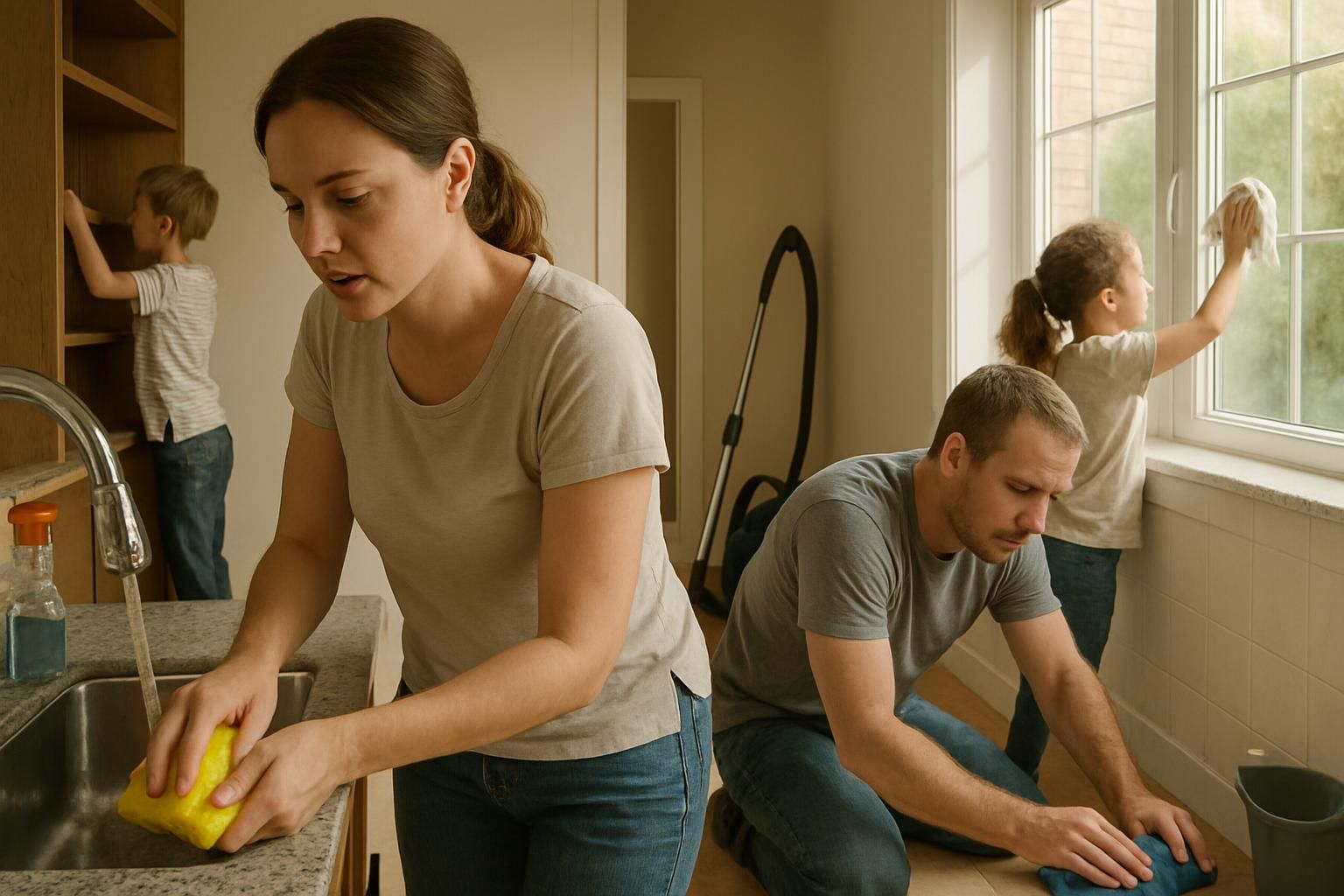
Cleaning a new home provides a fresh start for families and homeowners by clearing away construction dust, debris removal, hidden mold spores, or leftover grime from past residents.
A thorough deep cleaning takes only 1 to 2 days using basic cleaning supplies like an all-purpose cleaner, microfiber cloths, vacuum cleaner, mop and sponges. Proper window cleaning eliminates dirt and lets in more sunlight. Vacuuming carpets removes allergens that benefit indoor air quality throughout the house.
Changing old HVAC filters and sanitizing heating ducts also reduces pollutants so everyone breathes easier in their living space. Sanitizing areas such as toilet seats, kitchen sinks, shower doors and refrigerator interiors protects against harmful germs or bacteria. While revealing spots that need repair or safety fixes before settling into daily life.
Essential Cleaning Supplies for a New Home
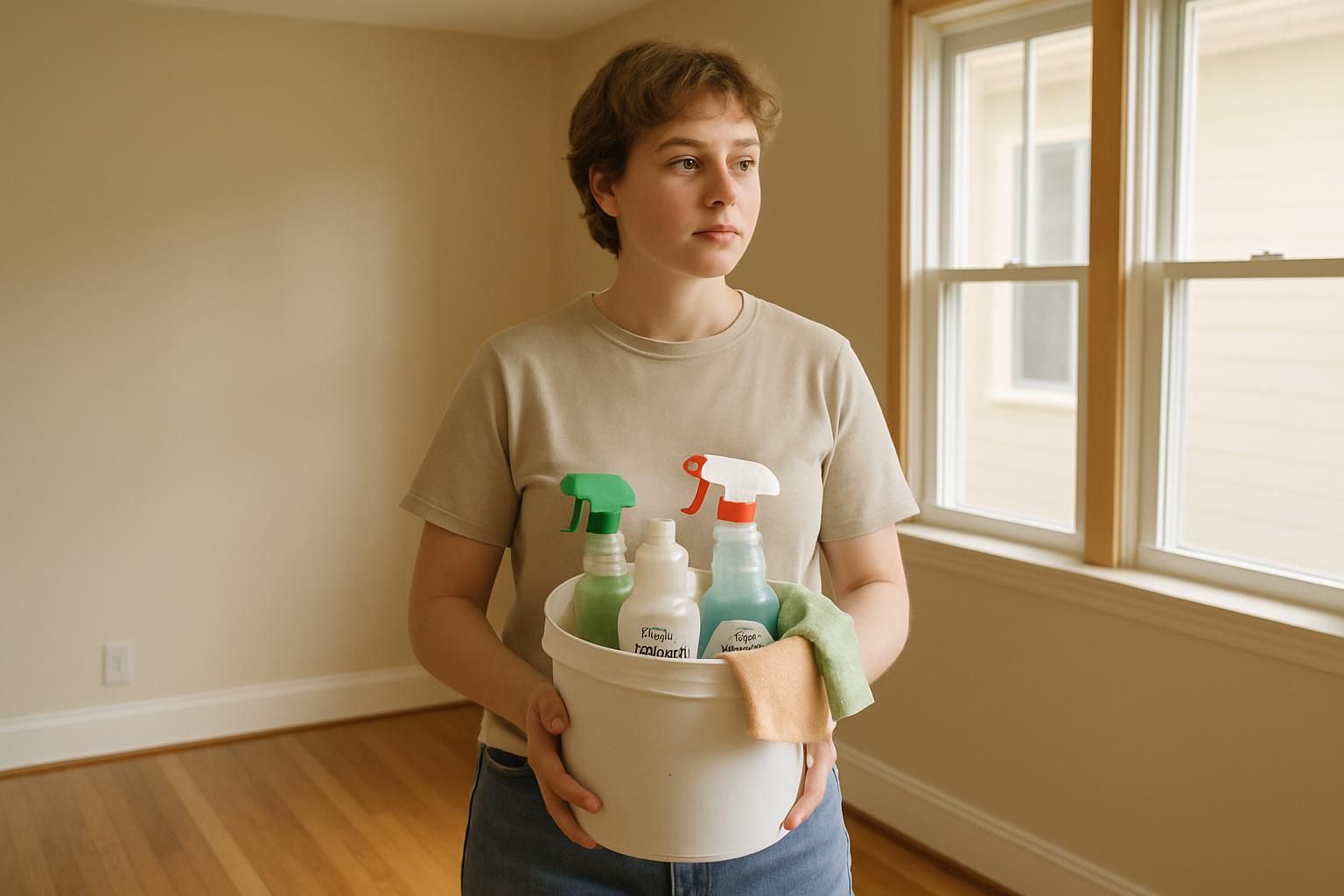
No one wants to tackle construction dust or greasy ovens bare-handed stocking up on sturdy rubber gloves can save a lot of headaches. A solid set of versatile cleaning supplies makes moving day less stressful and gets the new home sparkling in no time.
All-purpose cleaner
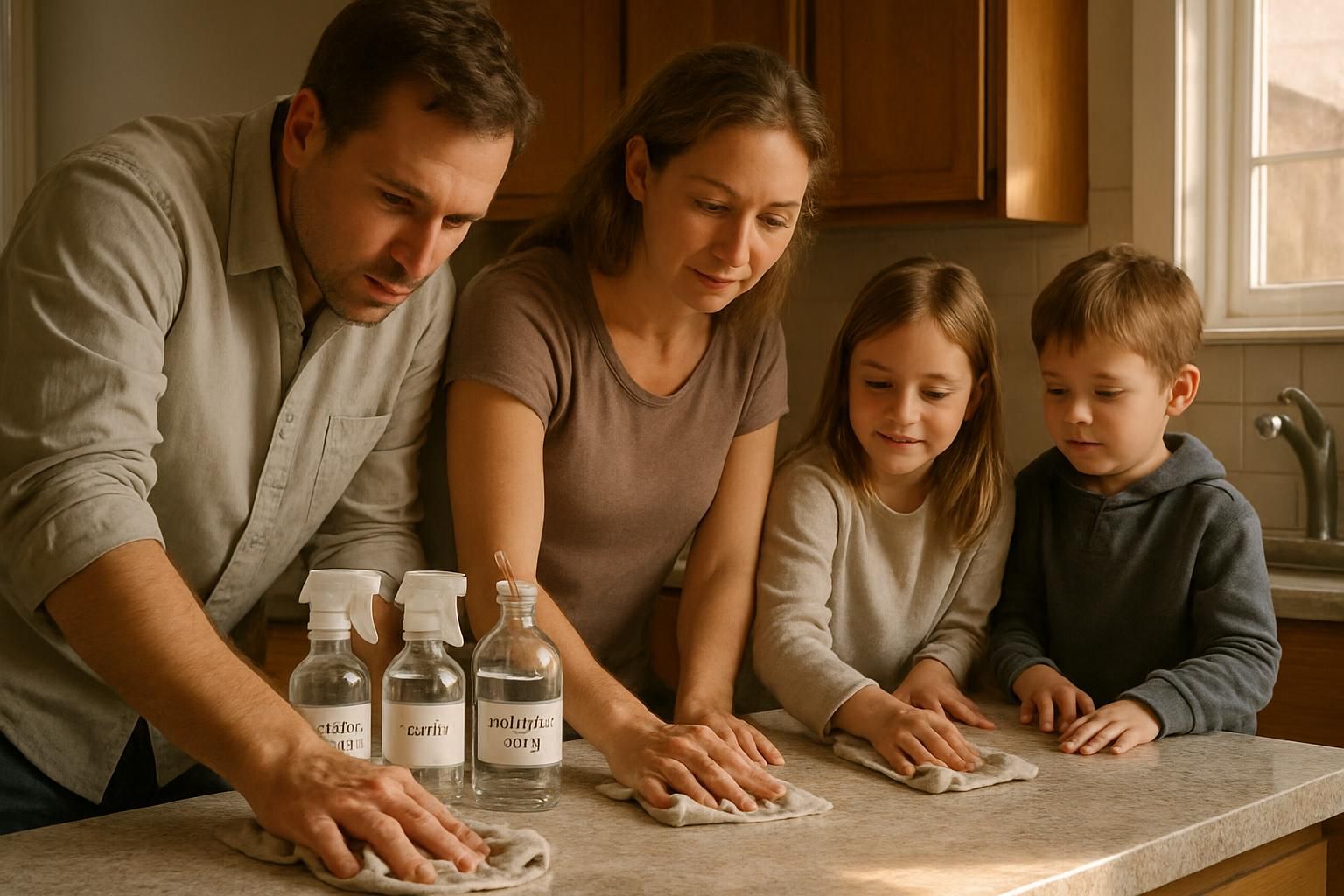
An all-purpose cleaner is a staple item in basic cleaning supplies and a lifesaver for busy homeowners. Families can whip up a DIY solution by mixing equal parts water and white vinegar with drops of essential oils. This blend tackles everything from kitchen cleaning to bathroom chores without harsh chemicals.
Its versatility covers many household areas like sink cleaning, linoleum floors, countertops, glass cleaner duties on mirrors or windows, and even tile floors. House owners find it useful against mold removal in showers or handling post-renovation messes filled with dust and debris.
Parents appreciate that it’s non-toxic yet powerful enough to handle deep-cleaning needs safely around children at home.
Microfiber cloths
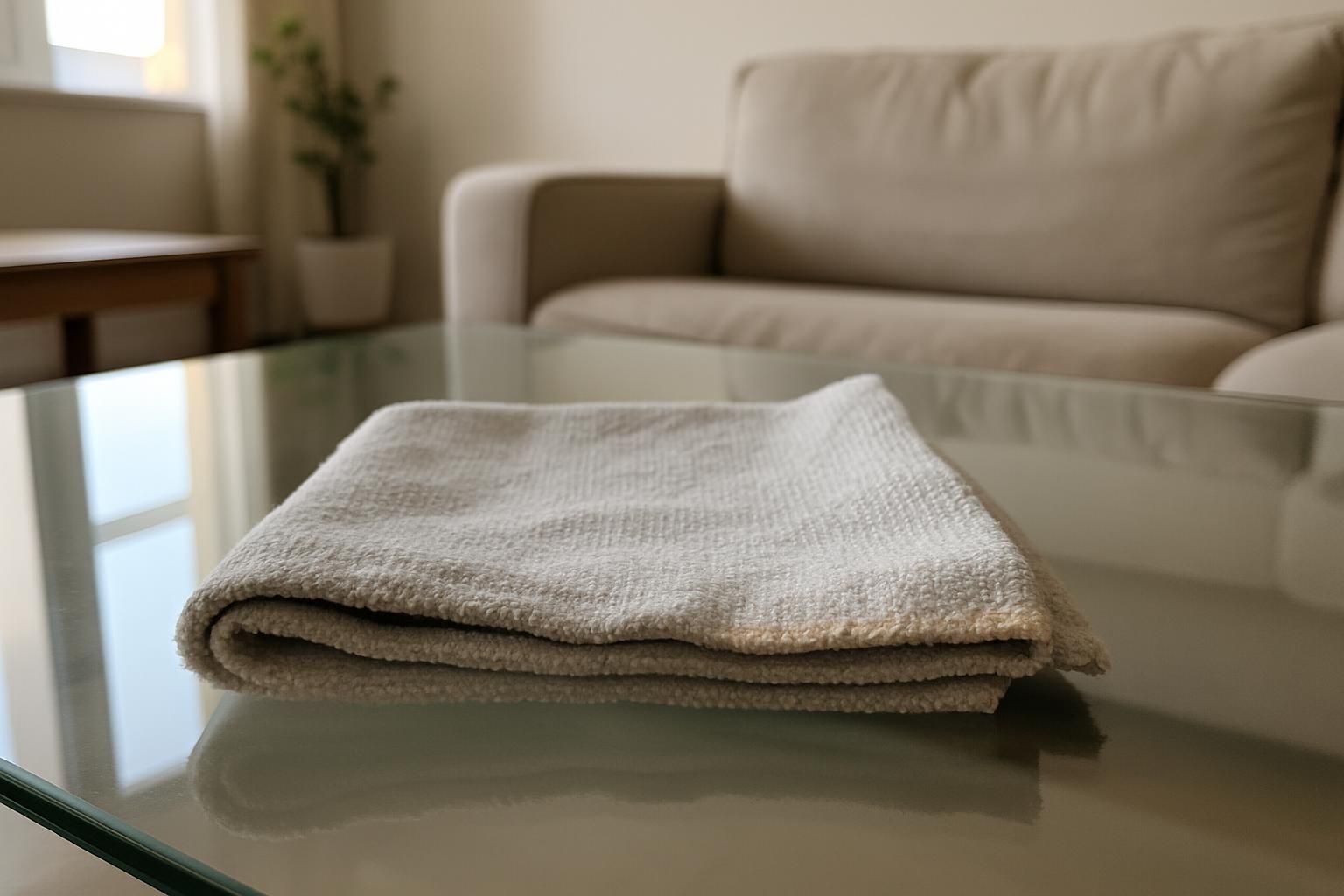
The microfiber cloths make cleaning faster and easier for busy parents and homeowners. Their tiny fibers grab dust, dirt, kitchen grease, and even hard water stains without harsh chemicals, making them an eco-friendly cleaning alternative.
In fact, microfiber reduces household waste by cutting down paper towel use. Each reusable cloth lasts up to 300 washes. Microfiber works wonders during window cleaning because it leaves no streaks or lint behind compared to traditional towels.
For living rooms with electronics or delicate surfaces, these soft yet effective rags safely catch construction dust and debris without scratching furniture finishes or TV screens.
After gathering microfiber cloths as essential cleaning supplies, house owners can move on confidently to picking the right vacuum cleaner and mop for their floors.
Vacuum and mop
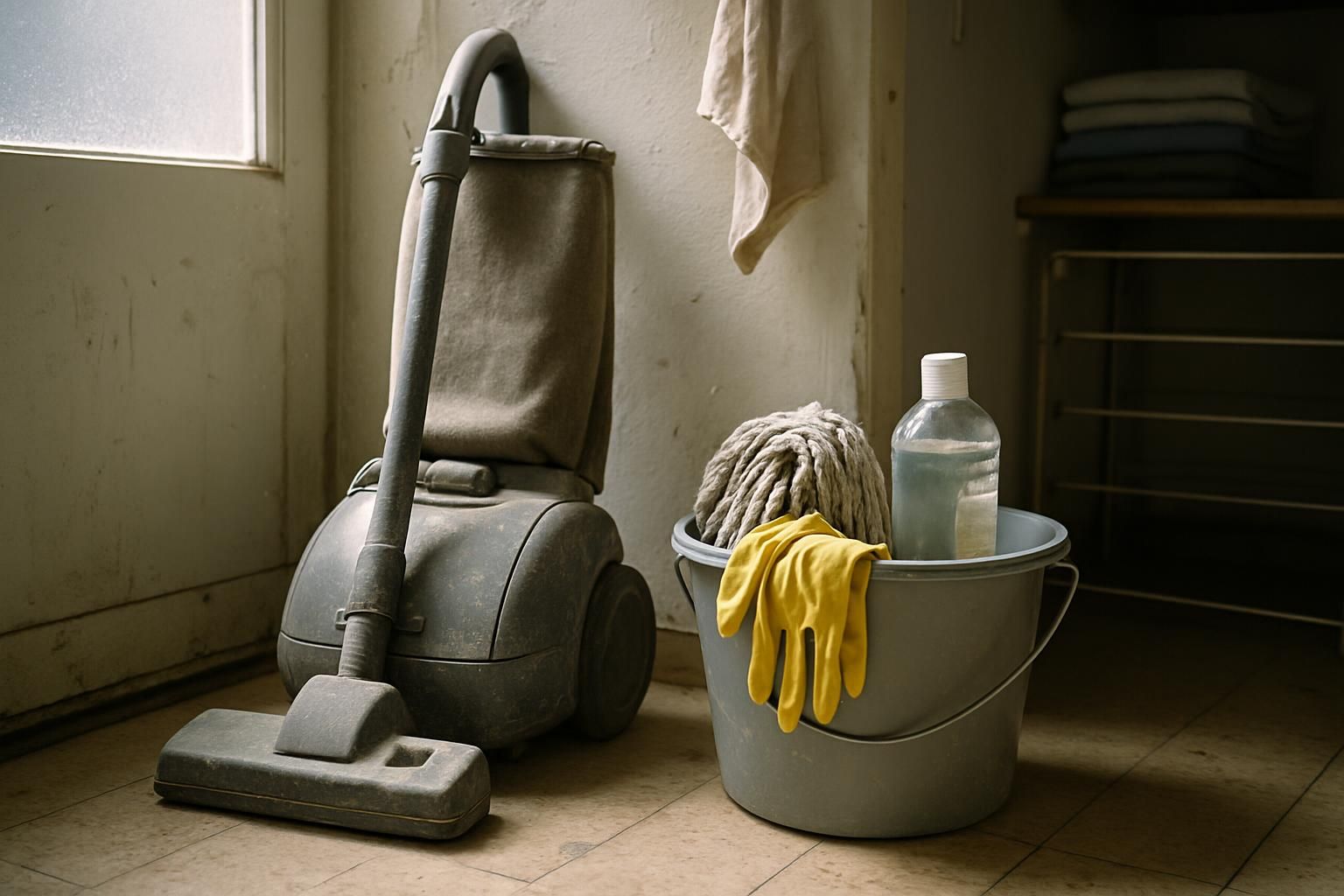
Vacuum cleaners do more than tidy carpets; they keep dust, debris, and allergens under control. This is why a vacuum with a HEPA filter works best for pet owners to trap dander and hair that regular models miss.
Hard floors call for effective mopping supplies: grab a mop, bucket, rags or microfiber cloths along with an all-purpose cleaner to tackle dirt without fuss. Using quality cleaning products like white vinegar mixed with hot water helps remove grime from tile floors or linoleum quickly and safely.
Households can also choose steam cleaners to freshen surfaces without chemicals. These tools sanitize effectively while staying family-friendly.
Disposable gloves
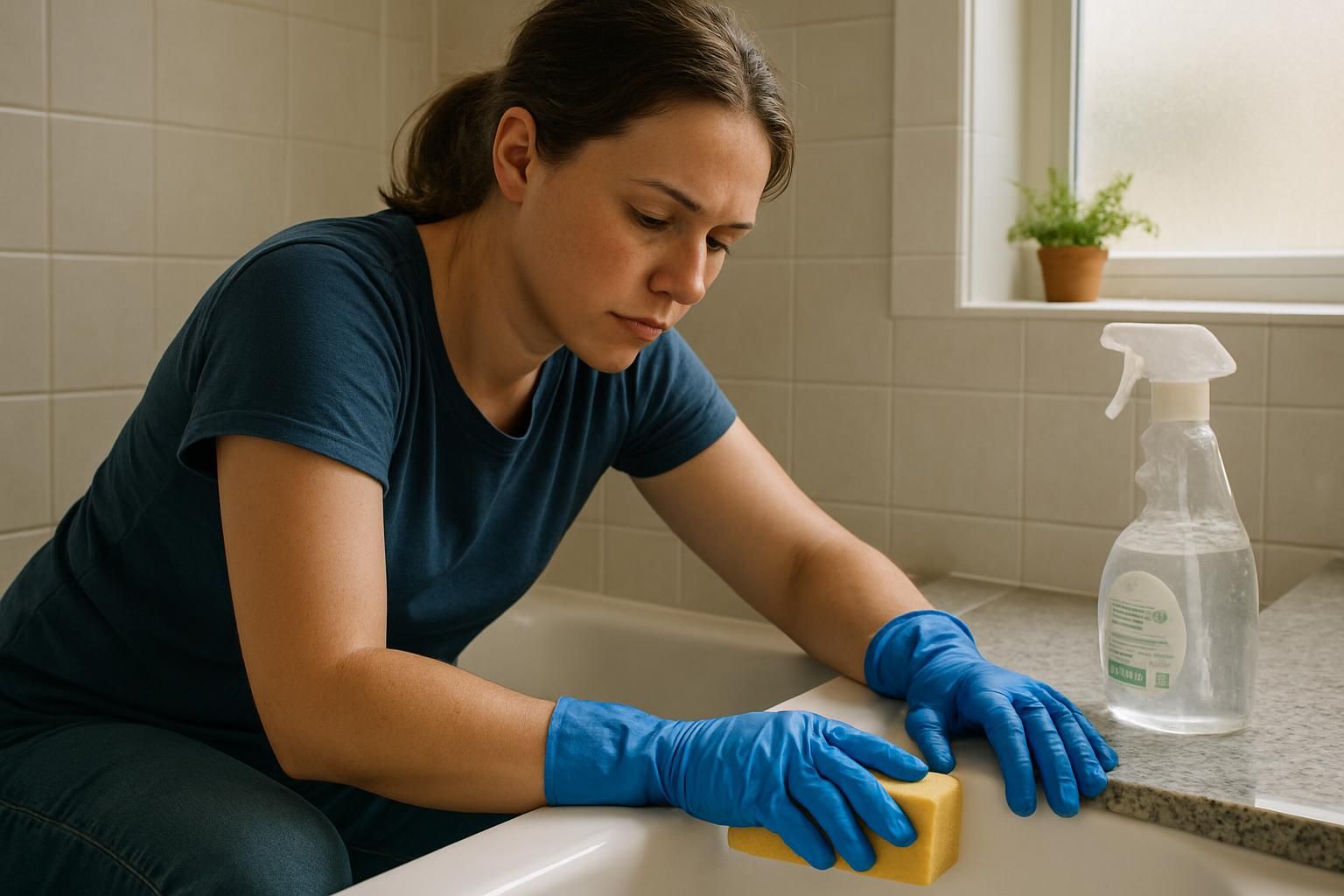
After floors are clean, disposable gloves keep hands safe from dirt and harsh chemicals. Gloves serve as important personal protective equipment. They shield skin from nasty germs during bathroom cleaning or kitchen cleaning tasks.
Wearing the right-sized rubber gloves helps homeowners stay comfortable while scrubbing moldy showers or tackling debris removal after new construction cleaning. Disposable gloves also lower cross-contamination risks when moving between oven cleaning, toilet disinfecting. Or handling hazardous materials left behind in post-build cleanup jobs.
Keeping a box within easy reach makes any deep cleaning quicker and safer for parents juggling busy move-in schedules.
Sponges and scrub brushes
Sponges and scrub brushes tackle tough stains easily. It absorbs liquids quickly, making them handy for kitchen cleaning tasks such as washing dishes or wiping countertops. Scrub brushes deal effectively with stubborn grime in bathroom cleaning. They remove hard water stains from tiles and mold buildup during shower cleaning routines.
Homeowners find these simple tools versatile enough to address various deep cleaning needs around sinks, ovens, microwaves, refrigerators, or even linoleum floors covered in post-construction dust and debris.
For safety precautions during heavier jobs like oven cleaning or mold removal projects using hydrogen peroxide solutions, disposable rubber gloves should accompany sponges and scrub brushes on the household’s essential cleaning supplies list.
Step-by-Step Move-In Cleaning Checklist
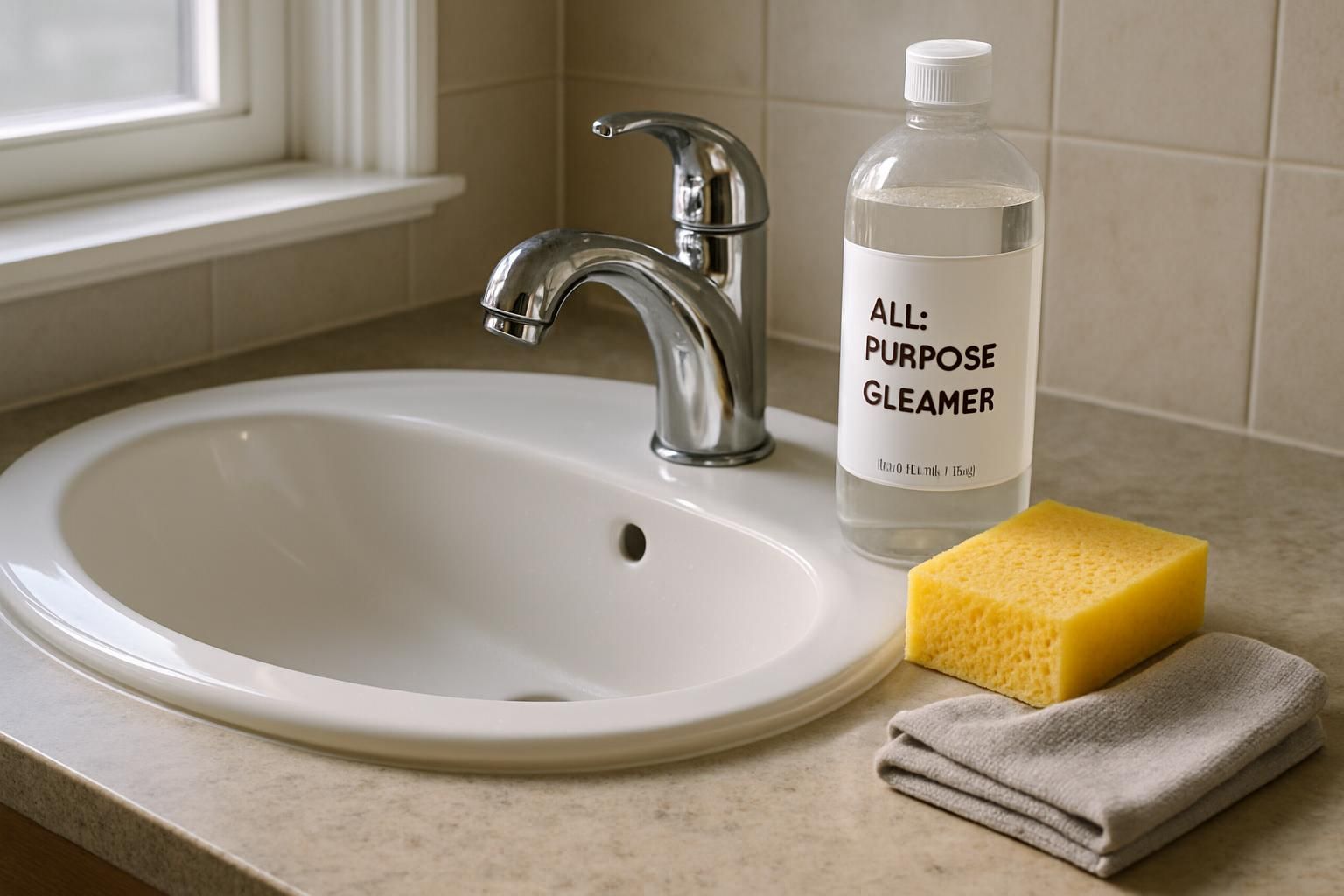
A reliable cleaning checklist helps homeowners tackle construction dust and debris without stress. With sponges, microfiber cloths, and an all-purpose cleaner handy, families can quickly make their new place sparkle from ceiling fixtures down to the floors.
Start by Decluttering and Removing Debris
Homeowners should first deal with dust and debris left from past occupants or post-construction cleaning. They can use simple tools like a broom, vacuum cleaner, and shop vac to quickly clear away construction materials, broken items, hazards such as wires that could cause electrocution risks or mold removal concerns; dispose of these properly to keep the family safe.
Professional services provide smart options for heavy-duty debris removal if major cleanups involve hazardous materials.
Clearing clutter simplifies moving day by giving owners a fresh start in their new home. It also helps identify pre-existing damage easily so homeowners can document it before settling in.
After clearing out clutter and unwanted things completely, some families choose saging their homes to cleanse negative energy for peace of mind before unpacking begins.
Dust and Wipe Down All Surfaces
With clutter and dust cleared away, attention moves onto thorough surface cleaning. Dusting spray paired with microfiber cloths easily remove hidden dirt and allergens lurking on shelves, counters, baseboards, ceiling fans, blinds, and light fixtures.
High-quality cleaning supplies like all-purpose cleaners can simplify wiping down tables, chairs, cabinets or furniture polished wood surfaces. Regularly clearing dust and debris helps improve air quality inside the house; clean homes reduce allergy symptoms for both children and adults alike.
Clean Windows and Mirrors
Cleaning windows and mirrors brightens rooms and improves natural light at home. Dirty glass surfaces block sunlight, causing dull, gloomy spaces. Using an effective window cleaning spray or a simple DIY cleaning solution with white vinegar easily removes grime and prevents streaks.
Microfiber cloths effectively trap dirt without scratching the surface, making them essential cleaning supplies for clear, spotless results. Regular window cleaning also reduces dust buildup that can worsen allergies in kids and adults alike.
Investing in basic tools like a handheld window squeegee makes the task easier, quicker, and even oddly satisfying.
Spotless mirrors also enhance visibility as well as the room’s appearance overall. Bathroom mirrors frequently collect water spots and toothpaste splatters that a sponge alone can’t handle efficiently; keeping them clean with glass or all-purpose cleaner is vital to maintain hygiene standards at home.
Simply spraying cleaner onto microfiber cloths instead of directly on mirror surfaces avoids wasteful drips onto counters or floors below. Clean bathroom mirrors instantly make morning routines less stressful for busy families rushing through daily tasks together.
Next up after sparkling windows comes sanitizing high-touch areas such as doorknobs, handles, and light switches throughout every room to create safer living spaces right from move-in day onward!
Sanitize Light Switches, Doorknobs, and Handles
High-touch points like doorknobs, faucets, handles and light switches easily attract germs. Using disposable gloves and an all-purpose cleaner once a week drastically reduces the spread of bacteria or viruses at home.
Regular sanitization is simple to include in any cleaning checklist; it makes managing household hygiene easier for busy parents and new house owners. Microfiber cloths work great with hydrogen peroxide-based sprays or diluted white vinegar solutions for disinfecting these areas effectively without harsh chemicals.
How to Deep Clean the Bathroom
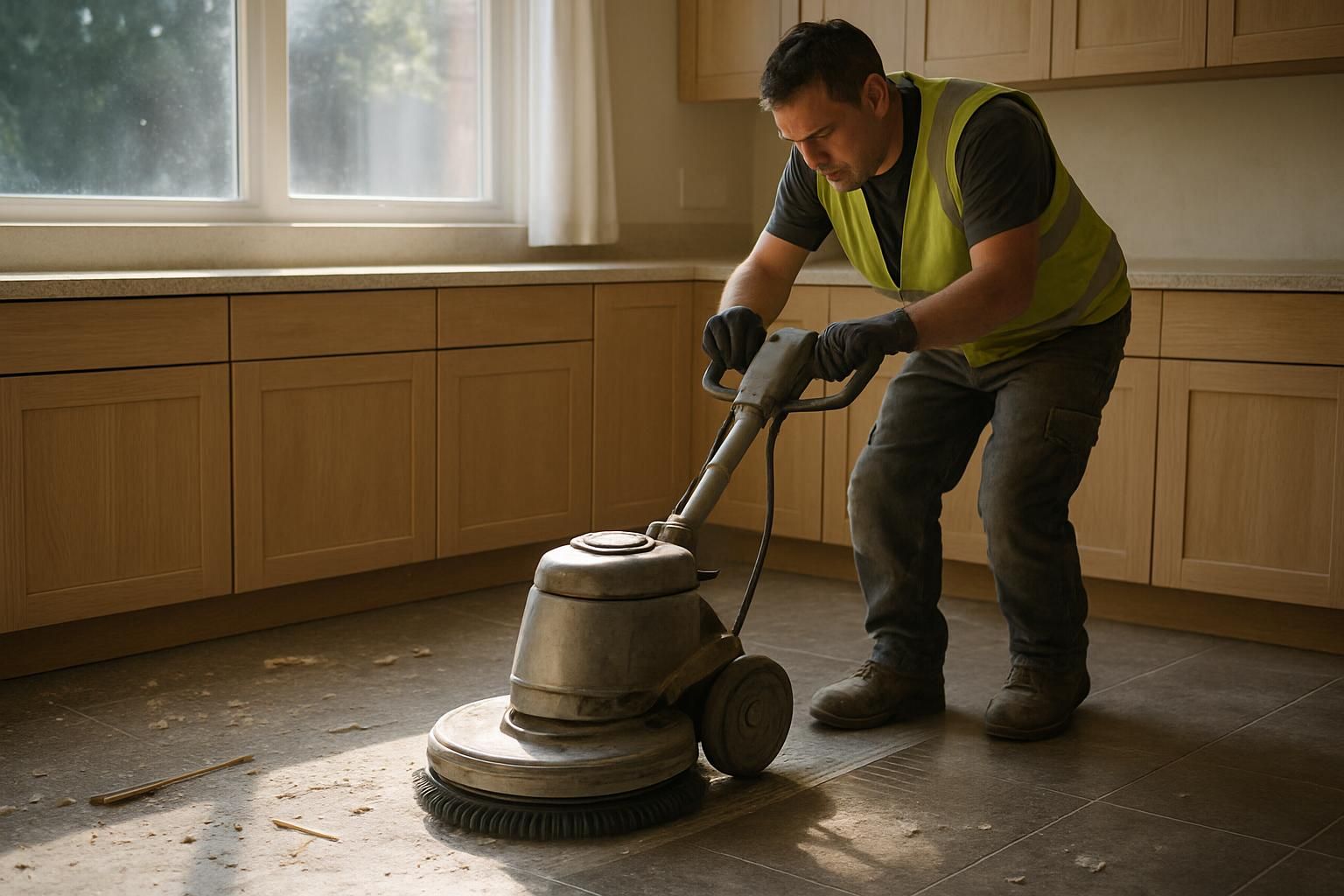
Bathrooms collect grime quickly, but with rubber gloves and the right cleaning supplies, homeowners can tackle toilets, tubs and tiles within a few hours. Baking soda paste or white vinegar makes tackling hard water stains and mold easy without harsh chemicals.
Scrub the Tub and Shower
House owners moving into a new place must scrub the tub and shower deeply using specific cleaners suited to their bathroom surfaces. Porcelain tubs respond best to a powder cleaner mixed with water, while tile showers usually need an effective tub and tile cleanser or DIY cleaning solutions like baking soda paste.
Regular shower cleaning prevents mold buildup, germs, soap scum, and persistent hard water stains. A durable sponge or scrub brush helps loosen tough grime easily; always rinse thoroughly after scrubbing for great results without unattractive residues.
Disinfect the Toilet
After scrubbing away grime and mold from the shower, disinfecting the toilet bowl is next on the bathroom cleaning list. For germ-free results, owners should choose effective disinfectants specifically designed for toilets.
First, apply a disinfecting cleaner under the rim and around inside surfaces of the toilet bowl; let this sit undisturbed for at least 5-10 minutes to eliminate germs thoroughly. Next, scrub firmly with a sturdy toilet brush to remove stains and stubborn dirt completely.
Disposable rubber gloves can protect hands while wiping exterior parts like seats, lids, handles, bases, and surrounding areas using microfiber cloths soaked in mild all-purpose cleaners or hydrogen peroxide-based solutions.
Regular toilet cleaning prevents hard water stains and reduces bacteria buildup that may impact household members’ health over time.
Clean Cabinets and Drawers
Cleaning cabinets and drawers clears away germs and dust from past users. House owners should start by removing any loose particles, dirt, or construction debris before scrubbing with an all-purpose cleaner or disinfectant spray.
Microfiber cloths help trap dust effectively; rubber gloves keep hands clear of harsh cleaning supplies. To handle tough grime buildup inside kitchen drawers, homeowners can use a mild baking soda paste mixed with white vinegar for spotless results that beat store-bought mixtures every time.
Households benefit greatly by adding cabinet liners once the surfaces fully dry. Lining shelves protects against future spills and simplifies regular deep cleaning routines in both kitchen cabinets and bathroom storage areas.
Regular wiping prevents stubborn stains from grease splatters, personal care products, or overlooked hazardous materials like old paint cans lurking deep within under-sink spaces.
Sanitize the Sink and Faucets
After cabinets and drawers sparkle, homeowners should turn attention to the bathroom sink and faucets. To achieve a clean environment for kids and family, warm soapy water mixed with an all-purpose cleaner makes the best solution.
A good scrub removes toothpaste, soap scum, or leftover debris; using disposable gloves keeps hands protected from harsh sanitizers like hydrogen peroxide or white vinegar. Finish by letting surfaces air-dry naturally to stop germs from spreading.
For drains, weekly treatment with baking soda paste followed by vinegar reduces odors and helps prevent hair clogs or mold buildup underneath.
How to Deep Clean the Kitchen

Deep cleaning the kitchen means tackling stubborn grime spots, getting cozy with your fridge and freezer interiors, and maybe even befriending some baking soda paste ready to dive into more tips?
Clean Cabinets and Drawers Inside and Out
Clean cabinets and drawers inside and out with an all-purpose cleaner to remove dust and debris. Dirt accumulates fast in kitchen cabinets, but regular cleaning prevents grime buildup.
Spraying surfaces with white vinegar then wiping dry with microfiber cloths kills germs without harsh chemicals. Using disposable gloves protects hands from household cleaners while working.
For stubborn stains, baking soda paste tackles tough spots without scratching surfaces or finishes. Shelf lining paper makes future clean-ups quicker after spills or leaks occur; parents especially favor this easy step for better kitchen hygiene day to day.
Scrub Countertops and Backsplash
After cabinets and drawers sparkle, countertops and backsplash tiles need attention next. Grease spots, sauce splashes, and dried food stains settle easily on these surfaces. House owners benefit from eco-friendly options like all-purpose cleaners or a DIY cleaning solution of baking soda paste to remove tough kitchen grime effectively.
For textured backsplash tiles where dirt hides in cracks, sponges or scrub brushes help lift debris fully without harming the surface finish. Regular scrubbing helps prevent heavy buildup of bacteria that can thrive around your sink and cooking area; disposable gloves keep hands protected while working with any cleaning supplies.
Clean Major Appliances (Stove, Refrigerator, Dishwasher)
Cleaning major appliances makes kitchens safer and healthier for families. Homeowners should unplug all appliances before starting. For stove cleaning, baking soda paste removes stubborn grease easily without harmful fumes.
A vinegar spray tackles food buildup on refrigerator shelves and drawers quickly; homeowners can also vacuum refrigerator coils with a flat vacuum attachment to keep the appliance efficient.
Dishwasher cleaning, however, often requires professional assistance every three to four months to prevent mold growth or drainage issues. Maintaining these kitchen cleaning tasks regularly helps protect investments in essential home equipment.
Next up is sanitizing the kitchen sink and drain effectively.
Sanitize the Sink and Drain
Sinks and drains gather grime quickly, especially in kitchens used daily. House owners must clean the sink with warm soapy water every day, particularly after handling raw meat to prevent harmful germs from spreading.
Twice a week, scrub kitchen sinks using an all-purpose cleaner or white vinegar to disinfect surfaces thoroughly. For removing drain buildup and odors naturally, sprinkle baking soda into the drain followed by one cup of white vinegar once per week.
This mixture reduces unpleasant smells and helps keep clogs away, ensuring smooth dish washing plus safe food prep areas for families.
Cleaning Floors in Your New Home

Floors can make or break the feel of a home, so house owners need to tackle carpets and hard floors with care. With tools like vacuum cleaners, steam mops, and simple DIY solutions such as white vinegar or baking soda paste at hand, spotless floors are within easy reach.
Vacuum and Clean Carpets
Vacuuming carpets regularly prevents dirt buildup and removes allergens, keeping indoor air fresh for parents and their kids. For deep cleaning, house owners can rent or buy a steam cleaner that provides hot water extraction to lift stubborn stains and pet odors.
Using a carpet cleaner with natural ingredients like baking soda paste or white vinegar tackles tough marks effectively without harsh chemicals. Selecting a HEPA vacuum offers better allergen control, making it ideal for families who deal with allergies or asthma concerns at home.
Sweep and Mop Hard Floors
Sweeping floors removes dust and debris easily tracked in during a move. It is smart to pick the right cleaner for each flooring type, especially wood floors, tile floors, or linoleum floors.
Regular sweeping and mopping prevent dirt buildup and keep spaces healthy for families with kids running around. Experts prefer microfiber cloths over regular mops as they trap dirt effectively without leaving streaks behind.
Doing this simple step at least once weekly maintains home hygiene and reduces allergens. After cleaning hard surfaces thoroughly, homeowners can make their space shine even brighter by taking steps to polish wood flooring next.
Polish Wood Flooring
After sweeping and mopping hard floors, polishing wood flooring keeps the home looking elegant. Applying a quality wood floor cleaner once a month can maintain durability in busy family homes.
Parents should skip steam cleaners, which may damage the wooden surface over time; instead, they can go eco-friendly with vinegar and water solutions. Resealing frequently used spaces helps protect wood floors from scuffs, dirt, and spills common among active households.
House owners find regular vacuuming combined with gentle cleaning products ideal for preserving natural beauty in their polished hardwood flooring.
Finishing Touches for a Fresh Start

Give your HVAC system some love, add a dash of essential oils, and breathe easy curious how these small touches make a big difference?
Replace Air Filters
Replacing air filters cuts down dust and debris, lowers energy bills, and improves home comfort. Dirty filters slow airflow through the HVAC system and push it harder, raising electricity use by almost 15%.
High-quality MERV-rated filters help control allergies caused by mold spores or construction dust lingering in the ducts. A homeowner needs no special training to swap the filter; simply turn off the furnace or cooling unit, remove the old one, slide in a clean replacement, then restart everything.
Doing this easy DIY every three months stretches out a home’s HVAC lifespan and creates cleaner indoor air for everyone’s health at home.
Disinfect HVAC Vents
HVAC systems significantly impact indoor air quality. Dirty vents can spread dust, allergens, and germs around the house if neglected. Regular cleaning prevents dust buildup and lowers airborne virus transmission, especially important post-pandemic with advancements in HVAC technology focused on improved airflow design.
For effective cleaning results, homeowners should first vacuum vents thoroughly to remove construction dust or debris left from new builds or renovations. Afterward, wiping down each vent cover carefully with a microfiber cloth lightly sprayed with an all-purpose cleaner helps eliminate remaining dirt effectively.
Deep vent duct cleaning may require professional assistance for hard-to-remove mold growth or hazardous materials hidden within ducts.
Adding air fresheners or diffusers afterward contributes to creating a pleasant atmosphere at home. And marks the finishing touch of a comprehensive move-in clean-up routine.
Add Air Fresheners or Diffusers
After disinfecting vents, adding air fresheners or diffusers boosts indoor ambiance with pleasant scents. Homeowners can pick from aerosol sprays, plug-in evaporators, automatic puff releasers, scented candles, incense sticks, and gel-based diffusers.
Scented candles work great in living rooms and bedrooms because they provide soft fragrance without overwhelming the space. Incense sticks and gel diffusers passively release fragrances into kitchens and busy areas slowly over time.
Regularly airing out rooms helps prevent strong scent buildup. Proper ventilation keeps spaces smelling clean instead of heavily perfumed.
Conclusion

A clean home sets the stage for a fresh start. With smart tools like microfiber cloths, baking soda paste, and an all-purpose cleaner, homeowners can easily tackle dirt, grime. And even stubborn hard water stains.
Adding essential oils or swapping out air filters brings a crisp feel to spaces big and small. A thorough deep cleaning also highlights potential issues needing repair. Plus it offers peace of mind knowing surfaces and fixtures are safe for family use.
Efficient preparation puts families on track to quickly settle into their new homes with comfort and confidence.
FAQs
1. What’s the best way to tackle kitchen cleaning in a new home?
Start by removing dust and debris from cabinets, counters, and appliances. Use an all-purpose cleaner for fridge cleaning, freezer cleaning, microwave cleaning, dishwasher cleaning, oven cleaning (or run your self-cleaning oven), and sink cleaning. Don’t forget rubber gloves; they’ll protect you from harsh chemicals.
2. How do I handle bathroom cleaning effectively after moving in?
Bathroom areas often hide mold or hard water stains on shower heads and tiles. Spray white vinegar or hydrogen peroxide solutions to remove mold safely. Scrub toilet bowls with baking soda paste for sparkling results without harmful fumes.
3. What should I include on my post-construction deep-cleaning checklist?
Your post-build checklist needs ceiling cleaning first to clear construction dust off light fixtures and wiring areas above eye level. Next comes window cleaning inside-out using DIY solutions mixed with essential oils for freshness. Finish floors last carpet cleaning machines work wonders here!
4. Can steam cleaners help clean linoleum floors better than regular methods?
Absolutely! Steam cleaners sanitize linoleum floors quickly while lifting stubborn dirt easily compared to traditional mops alone. Plus no hazardous materials involved means safer surfaces overall.
5. Is there an easy method for wood floor care during move-in cleanup tasks?
Wood floors need gentle attention when clearing away leftover construction materials or debris. Removal efforts after renovations end successfully at home sites everywhere today! Sweep carefully before lightly damp-mopping them dry immediately afterward. So moisture won’t damage their beauty long-term either way around it now folks!

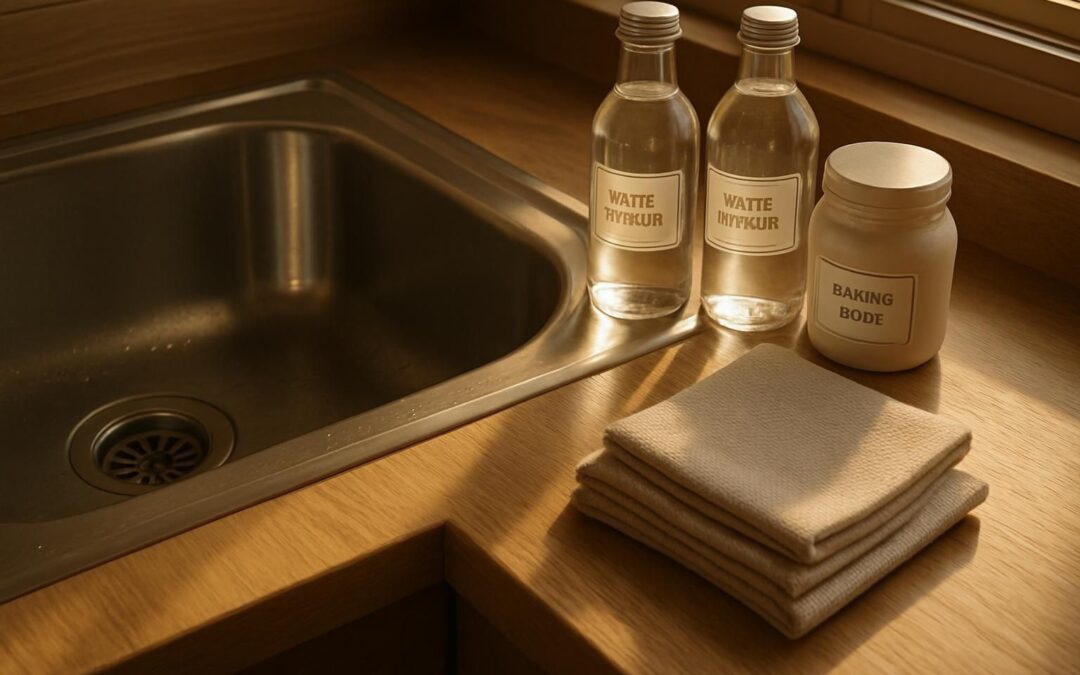

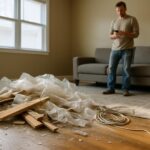

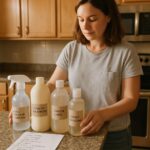

Recent Comments